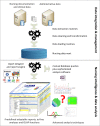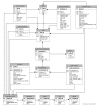A Nursing Intelligence System to Support Secondary Use of Nursing Routine Data
- PMID: 26171085
- PMCID: PMC4493340
- DOI: 10.4338/ACI-2015-04-RA-0037
A Nursing Intelligence System to Support Secondary Use of Nursing Routine Data
Abstract
Background: Nursing care is facing exponential growth of information from nursing documentation. This amount of electronically available data collected routinely opens up new opportunities for secondary use.
Objectives: To present a case study of a nursing intelligence system for reusing routinely collected nursing documentation data for multiple purposes, including quality management of nursing care.
Methods: The SPIRIT framework for systematically planning the reuse of clinical routine data was leveraged to design a nursing intelligence system which then was implemented using open source tools in a large university hospital group following the spiral model of software engineering.
Results: The nursing intelligence system is in routine use now and updated regularly, and includes over 40 million data sets. It allows the outcome and quality analysis of data related to the nursing process.
Conclusions: Following a systematic approach for planning and designing a solution for reusing routine care data appeared to be successful. The resulting nursing intelligence system is useful in practice now, but remains malleable for future changes.
Keywords: Medical informatics; data integration; data mining; databases; nursing informatics.
Conflict of interest statement
The authors declare that they have no conflicts of interest in the research.
Figures




Similar articles
-
SPIRIT: Systematic Planning of Intelligent Reuse of Integrated Clinical Routine Data. A Conceptual Best-practice Framework and Procedure Model.Methods Inf Med. 2016;55(2):114-24. doi: 10.3414/ME15-01-0045. Epub 2016 Jan 15. Methods Inf Med. 2016. PMID: 26769124
-
Informatics for patient safety: a nursing research perspective.Annu Rev Nurs Res. 2006;24:219-54. Annu Rev Nurs Res. 2006. PMID: 17078416 Review.
-
Nursing constraint models for electronic health records: a vision for domain knowledge governance.Int J Med Inform. 2005 Dec;74(11-12):886-98. doi: 10.1016/j.ijmedinf.2005.07.013. Epub 2005 Aug 22. Int J Med Inform. 2005. PMID: 16115795
-
osni.info-Using free/libre/open source software to build a virtual international community for open source nursing informatics.Int J Med Inform. 2005 Dec;74(11-12):937-45. doi: 10.1016/j.ijmedinf.2005.07.023. Epub 2005 Aug 19. Int J Med Inform. 2005. PMID: 16112895
-
Measuring spiritual care with informatics.ANS Adv Nurs Sci. 2009 Jul-Sep;32(3):200-10. doi: 10.1097/ANS.0b013e3181b0d6a6. ANS Adv Nurs Sci. 2009. PMID: 19707089 Review.
Cited by
-
A Novel Use of Bar Code Medication Administration Data to Assess Nurse Staffing and Workload.Appl Clin Inform. 2023 Jan;14(1):76-90. doi: 10.1055/a-1993-7627. Epub 2022 Dec 6. Appl Clin Inform. 2023. PMID: 36473498 Free PMC article.
-
Nursing Attitudes and Practices in Code Documentation Employing a New Electronic Health Record.Appl Clin Inform. 2021 May;12(3):589-596. doi: 10.1055/s-0041-1731340. Epub 2021 Jun 23. Appl Clin Inform. 2021. PMID: 34161987 Free PMC article.
-
The Role of Free/Libre and Open Source Software in Learning Health Systems.Yearb Med Inform. 2017 Aug;26(1):53-58. doi: 10.15265/IY-2017-006. Epub 2017 Sep 11. Yearb Med Inform. 2017. PMID: 28480476 Free PMC article.
-
Technology Informatics Guiding Education Reform - TIGER.Methods Inf Med. 2018 Jun;57(S 01):e30-e42. doi: 10.3414/ME17-01-0155. Epub 2018 Jun 20. Methods Inf Med. 2018. PMID: 29956297 Free PMC article.
References
-
- Leiner F, Haux R. Systematic Planning of Clinical Documentation. Methods Inf Med 1996; 35(1):25–34. - PubMed
-
- Mayer-Schönberger V, Cukier K. Big Data: A Revolution that Will Transform how We Live, Work, and Think: Houghton Mifflin Harcourt; 2013.
-
- Joint Commission on Accreditation of Healthcare Organizations. Primer on indicator development and application : measuring quality in health care. Oakbrook Terrace, Ill.: Joint Commission on Accreditation of Healthcare Organizations; 1990.
Publication types
MeSH terms
LinkOut - more resources
Full Text Sources

